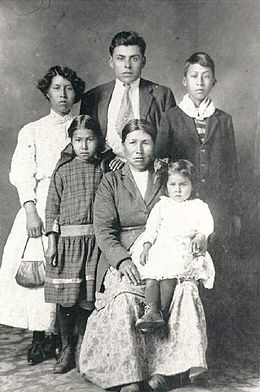Syilx
 Okanagan family, c. 1918 | |
| Regions with significant populations | |
|---|---|
| Canada (British Columbia), United States (Washington) | |
| Languages | |
| English, Okanagan (n̓səl̓xcin) | |
| Related ethnic groups | |
| Colville, Sanpoil, Nespelem, Sinixt, Wenatchi, Entiat, Methow, Palus, Sinkiuse-Columbia, and the Nez Perce of Chief Joseph's band |
The Syilx (Salishan pronunciation: [sjilx]) people, also known as the Okanagan, Okanogan or Okinagan people, are a First Nations and Native American people whose traditional territory spans the Canada–US boundary in Washington state and British Columbia in the Okanagan Country region. They are part of the Interior Salish ethnological and linguistic grouping. The Syilx are closely related to the Spokan, Sinixt, Nez Perce, Pend Oreille, Secwepemc and Nlaka'pamux peoples of the same Northwest Plateau region.
History
At the height of Syilx culture, about 3000 years ago, it is estimated that 12,000 people lived in this valley and surrounding areas. The Syilx employed an adaptive strategy, moving within traditional areas throughout the year to fish, hunt, or collect food, while in the winter months, they lived in semi-permanent villages of kekulis, a type of pithouse.[1]
When the Oregon Treaty partitioned the Pacific Northwest in 1846, the portion of the tribe remaining in what became Washington Territory reorganized under Chief Tonasket as a separate group from the majority of the Syilx, whose communities remain in Canada. The Okanagan Tribal Alliance, however, incorporates the American branch of the Syilx. The latter are part of the Confederated Tribes of the Colville, a multi-tribal government in Washington state.
The bounds of Syilx territory are roughly the basin of Okanagan Lake and the Okanagan River, plus the basin of the Similkameen River to the west of the Okanagan valley, and some of the uppermost valley of the Nicola River. The various Syilx communities in British Columbia and Washington form the Okanagan Nation Alliance, a border-spanning organization which includes American-side Syilx residents in the Colville Indian Reservation, where the Syilx are sometimes known as Colvilles.
The Upper Nicola Indian Band, a Syilx group of the Nicola Valley, which was at the northwestern perimeter of Okanagan territory, are known in their dialect as the Spaxomin, and are joint members in a historic alliance with neighbouring communities of the Nlaka'pamux in the region known as the Nicola Country, which is named after the 19th-century chief who founded the alliance, Nicola. This alliance today is manifested in the Nicola Tribal Association.
Customs
One of the unique customs of the Okanagan people was their propensity to sing when giving thanks for food and for healing.[2]
Language
The language of the Syilx people is Nsyilxcən. "Syilx" is at the root of the language name Nsyilxcən, surrounded by a prefix and suffix indicating a language.[3] Nsyilxcən is an Interior Salish language that is spoken across the Canadian and U.S.A. border in the regions of southern British Columbia and northern Washington.[4] This language is currently endangered and has only 50 fluent speakers remaining.[4]
Governments
- Okanagan Nation Alliance
- Westbank First Nation (Westbank)
- Lower Similkameen Indian Band (Keremeos)
- Upper Similkameen Indian Band (Keremeos)
- Osoyoos Indian Band
- Penticton Indian Band
- Okanagan Indian Band (Vernon)
- Upper Nicola Indian Band (Douglas Lake) - also part of the Nicola Tribal Association
- Confederated Tribes of the Colville
See also
References
- ^ John D. Greenough, Murray A. Roed, ed. (2004). Okanagan Geology. Kelowna Geology Committee. pp. 71–83. ISBN 0-9699795-2-5.
- ^ Okanagan Tribal Council; Edwards, Ken (Colville), illus. How Food Was Given. Penticton, B.C.: Theytus Books; 1984 (OCLC 15964121)(ISBN 9780919441071)
- ^ Johnson, M. K. (2012). k^sup w^u_sq^sup w^a?q^sup w^a?álx (we begin to speak): Our journey within nsyilxcn (okanagan) language revitalization. Canadian Journal of Native Education, 35(1), 79.
- ^ a b Johnson, Sʔímlaʔx Michele K. (November 2017). "Syilx Language House: How and Why We Are Delivering 2,000 Decolonizing Hours in Nsyilxcn". Canadian Modern Language Review. 73 (4): 509–537. doi:10.3138/cmlr.4040. ISSN 0008-4506. S2CID 149072885.
Further reading
- Armstrong, Jeannette, and Lee Maracle, Okanagan Rights Committee; Delphine Derickson, Okanagan Indian Education Resource Society, We Get Our Living Like Milk from the Land, Theytus Books, 1994
- Boas, Franz (1917). Folk-tales of Salishan and Sahaptin tribes. Published for the American Folk-Lore Society by G.E. Stechert & Co. ISBN 9780659903273.Available online through the Washington State Library's Classics in Washington History collection Includes: Okanagon tales by James A. Teit and Okanagon tales by Marian K. Gould.
- Carstens, Peter. The Queen's People: A Study of Hegemony, Coercion, and Accommodation Among the Okanagan of Canada. Toronto: University of Toronto Press, 1991. ISBN 0-8020-5893-0
- Robinson, Harry, and Wendy C. Wickwire. Nature Power: In the Spirit of an Okanagan Storyteller. Vancouver: Douglas & McIntyre, 1992. ISBN 1-55054-060-2
